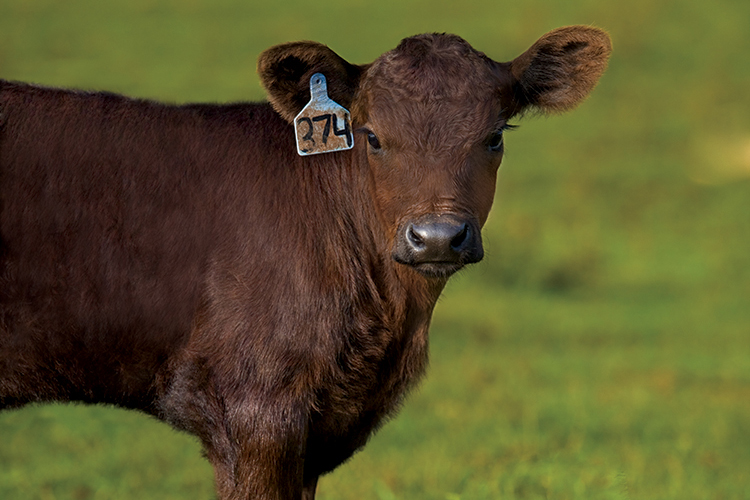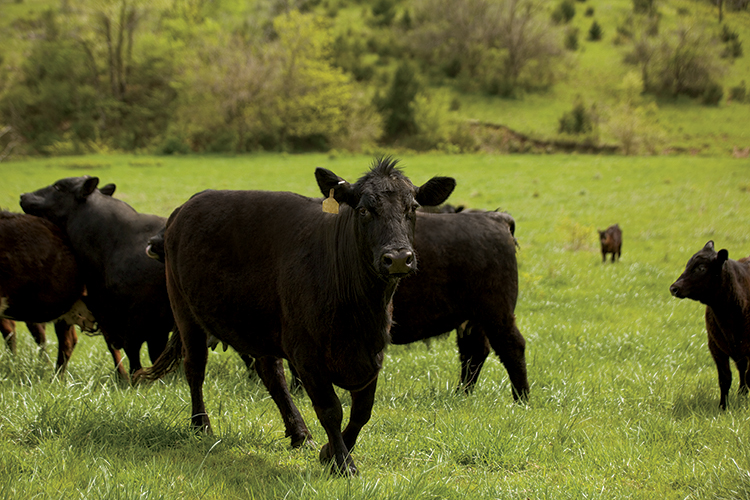Home > Missouri > Missouri Crops & Livestock > Beefing Up Profits
Beefing Up Profits

Missouri farmers and ranchers produce the best beef in the country with a competitive advantage in beef cattle genetics and high-quality feed.
At 1.88 million head, Missouri’s beef cattle herd ranks third in size in the nation. However, most calves leave the state before farmers and ranchers can fully reap the economic benefits.
“The majority of our calves are fed (to finish weight) out of state,” says Monty Kerley, University of Missouri cattle nutritionist.
Many of the calves are sold to neighboring states like Kansas and Nebraska to finish raising them to maturity. Missouri cattle are sought out because their superior meat quality returns a higher profit. Once they leave the state, Missouri cattle producers lose out on a major financial opportunity. “The longer the cow-calf producer owns the calf, the greater the economic advantage you get from the genetics,” Kerley says.
![Missouri Beef [INFOGRAPHIC]](https://eadn-wc01-4177395.nxedge.io/wp-content/uploads/2020/05/Screen-Shot-2015-07-17-at-1.58.43-PM.png)
In order to retain a herd for a longer period of time, some producers are utilizing new technology and infrastructure. On his farm near Boonville, Danny Wassman built a hoop building in 2013 to provide shelter for cattle. The building can hold up to 320 finished cattle until they are ready for market. “Starting to feed cattle was my next move to stay in the cattle business for the long-term,” Wassman says.
He raises 400 cows in partnership with his father, George. His younger brother, Dustin, also works on the farm. Wassman says he makes about $100 more per head by feeding out the cattle before marketing them.
When it comes to cattle nutrition, Missouri farmers have a natural advantage – easy access to quality, abundant feed – due to national rankings of sixth and seventh in soybean and corn production, respectively.
“Our state has plenty of pasture and grain, as well as byproducts from ethanol plants and brewers,” Kerley says.
Wassman also recognizes the advantage of feeding his cattle Missouri feed, noting that affordable feed costs were a big factor in his decision to finish cattle. “We grow all our own feed, except some dried distillers grains that we buy from ethanol plants,” he says.

Distillers grains – byproducts of ethanol production – add nutritional value at an economical cost, says Nick Hammett, marketing manager at Circle A Angus Ranch in Iberia. In 1995, Circle A began collecting data from Western finishing locations to monitor calf performance.
“Over years and years, we saw our cattle’s feed efficiency (amount of feed needed for the animal to gain 1 pound) getting better and better, and the quality of our beef was improving,” Hammett says. “We decided to realize that value ourselves.”
In 2007, Circle A started finishing cattle – putting calves on feed until they reach maturity – at a 7.5-acre covered facility holding up to 5,000 head. The 25,000-acre ranch finishes its own calves and ships them out of state for production.
It also buys back feeder calves from Missouri cattle producers that purchase Circle A breeding stock. Farmers who sell their calves back to Circle A receive the top price being paid for cattle in their region, as well as premiums for following Circle A’s health and genetic guidelines. Hammett says that 98 percent of the 10,000 head Circle A ships come from Missouri farms.
Wassman and Hammett both see the benefit of growing the herd by adding weight to cattle with Missouri feed. This contributes to more local jobs, growth in the community and additional agricultural opportunities.



